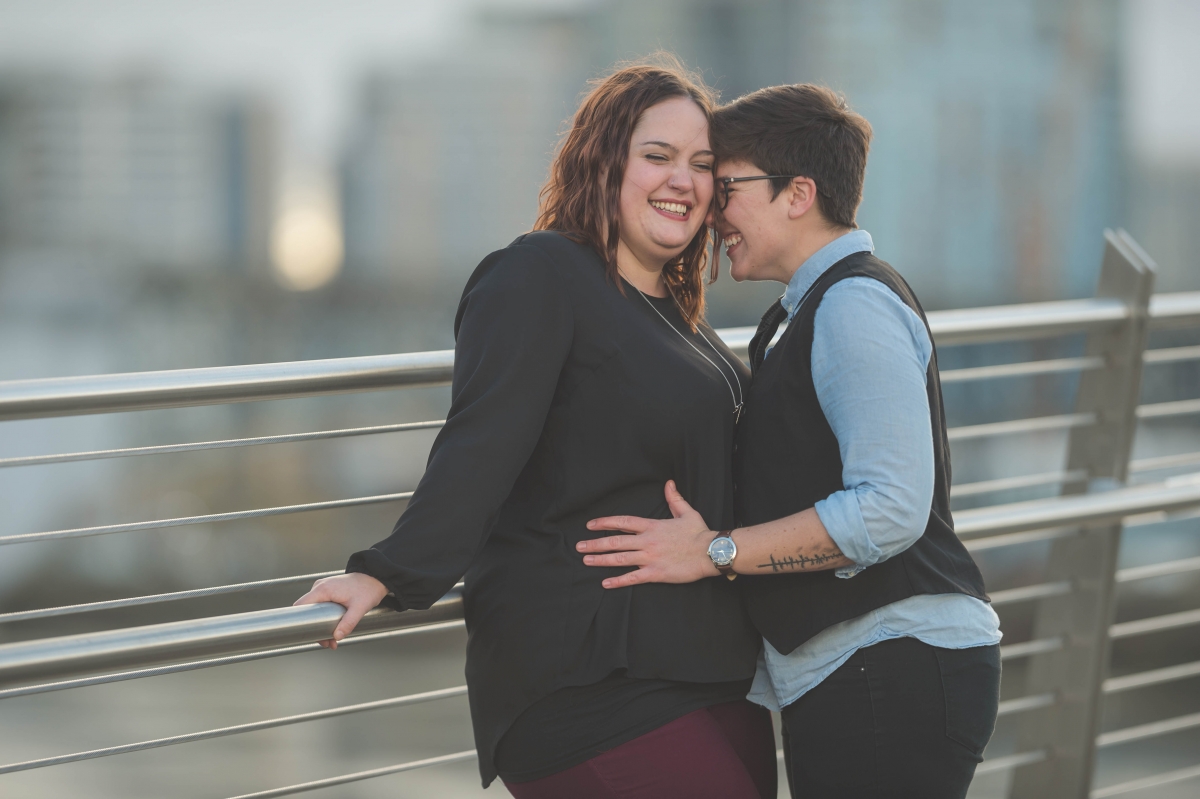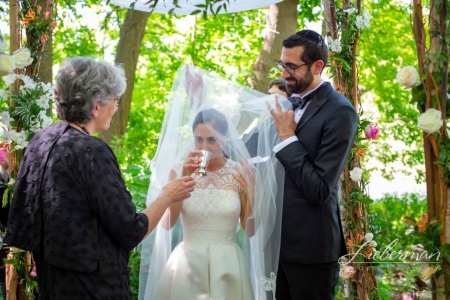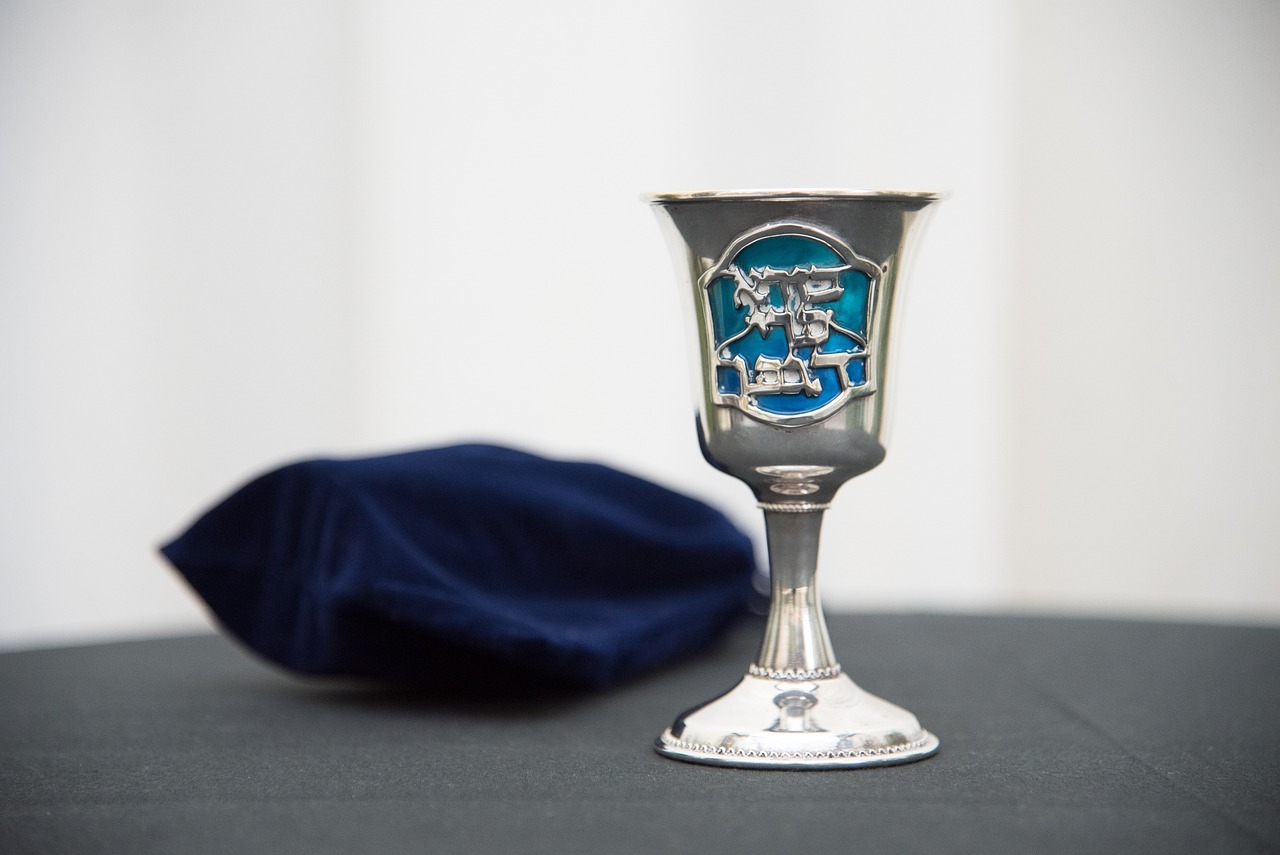Mikveh: Making the Transition
As part of our wedding preparations, Sue and Ben each went to the local mikveh or ritual bath, which is customary for brides and grooms. The wedding day is considered to be a personal Yom Kippur for the groom and the bride—a day on which “old business” is cleansed away, a day full of new possibility and awe—and so a trip to the mikvah symbolizes a cleansing, a fresh start, even a rebirth.
Tisches
At 11:00 a.m., the men will gather with Ben in the hall outside the synagogue offices, and the women with Sue in the Goodman Room, where we will each have a tisch (Yiddish for “table”), combining singing and words of blessing and learning. Our friends Yossi Abramowitz and Rabbi Susan Silverman will preside. At approximately 11:25 a.m., after Ben’s daughters have served as messengers and verified with each group that the bride and groom are ready, we will be danced into the lobby—by you!—for our joint tisch. This will be the first time we see each other since we separated at the end of Shabbat yesterday.
The joint tisch, facilitated by our friend Rabbi Deborah Glanzberg-Krainin, will be punctuated throughout by more singing. Our friend Elizabeth Mark will deliver a d’var torah (a talk reflecting Jewish learning). The tisch will also include the…
Acquiring and Signing of the Ketubah
For observant-yet-liberal Jewish couples like us, the traditional ketubah (wedding contract) is something to neither abandon nor leave entirely unchanged. The basis for our ketubah is a halakhic (legally valid) but non-standard text (affectionately known as the “napkin ketubah” because its first draft was, in fact, written on a cocktail napkin) composed by our m’sader kiddushin (officiant), Rabbi Gordon Tucker, in which the couple’s joint promises to support and sustain each other supplement the traditional obligations of husband to wife. We have also added language which reflects an expanded vision of our promises to each other: not merely to sustain each other materially, but also to take seriously what it means to build a loving partnership, God willing, over a lifetime.
The English translation of our ketubah text follows:
On the first day of the week of Parshat Ki Tissa, the sixteenth day of the month of Adar, in the year five thousand seven hundred sixty-one since the creation of the world, corresponding to the eleventh day of March, in the year two thousand one, according to the way we count time here in Cherry Hill, New Jersey, we attest that the groom, Benjamin Avram Kruskal, son of Rachel and Joseph, said to the bride, Susan Paula Fendrick, daughter of Kim and David: “Be my wife. Behold you are consecrated unto me, with this ring, according to the tradition of Moses and Israel.” And the bride, Susan Paula Fendrick, daughter of Kim and David said to the groom, Benjamin Avram Kruskal, son of Rachel and Joseph, “Be my husband. Behold you are consecrated unto me, with this ring, according to the tradition of Moses and Israel.”
The bride accepted a ring from her heart’s chosen one, and the groom accepted a ring from his heart’s chosen one, for the purpose of kiddushin and as a symbol of their love. The groom and the bride also placed together items of value belonging to each of them, and have accepted joint ownership of them, for the purpose of partnership and as a symbol of their bond, so that their marriage may be known among the people Israel as the joining of equals. And they said to each other, “You are my partner. I will treasure you as the most precious friend of my heart.”
The bride, Susan Paula Fendrick, and the groom, Benjamin Avram Kruskal, accepted upon themselves all the terms of betrothal and marriage to which they are obligated by biblical law and by the rulings of our Sages of blessed memory, as well as full legal responsibility for the terms of this ketubah, and agreed that these obligations may be satisfied from any of their real or moveable property entering this marriage. They also willingly agreed to work for one another, to honor and sustain and nourish one another, to care together for the groom’s daughters Meira Johanna, Shoshana Elisheva, and Adina Tamar, and for any other children with which they may be blessed, to live together as a family, and to build a household of integrity among the people Israel.
The groom and the bride further said: “As partners and as lovers, we will shape a life filled with Torah and mitzvot, for they are our life and the length of our days. We will listen with loving attention, and we will be honest and faithful to each other. Should dark days come upon us, we will work with all that we have to preserve and strengthen our partnership. We will accompany one another through sorrow and joy, and ever strive to grow as individuals and as a family. We hope not to fear change, but to nurture it as a source of ever-renewed love. We will work to express our deepest values through our daily actions, to infuse the everyday with a sense of purpose and holiness, and to support and challenge each other in our respective life’s work and in the sacred task of raising children.
“May our home give life to acts of kindness, righteousness, and the pursuit of justice. May we build a generous household, ever aware of God’s presence, open to and embraced by family, friends, and community, like the chuppah under which we are marrying today.
“To all this we commit ourselves with full understanding, as a sacred promise.”
We have had both the groom, Benjamin Avram Kruskal, and the bride, Susan Paula Fendrick, formally acquire these obligations to each other with an instrument fit for such purposes. Thus, everything is in order and in force.
As a legal and binding document, the ketubah requires two witnesses to confirm with their signatures that we have taken on these commitments to each other. We have asked our friends Rabbi Joel Alter and Mimi Zukoff to be the ketubah witnesses; they will also witness the acceptance of the rings during the ceremony.
Our ketubah is an original work in papercut and ink by Judaica artist Elana Weinberg. It will be on display throughout the day.
After we formally acquire all the obligations of the ketubah (the acquisition is called kinyan), it is time for the…
Bedecken
The traditional Jewish practice of the bridal veil, lowered by the groom just before the wedding ceremony, is customarily connected to two biblical events: Rebecca veiling herself when she first sees Isaac, the man who will be her husband (a reflection, many say, of modesty), and Jacob being tricked by his father-in-law into marrying the “wrong” sister, Leah, before he is permitted to marry his beloved Rachel (and thus the groom must do a “checking,” or bedecken in Yiddish, to make sure he’s marrying the right woman). Neither of these associations was particularly compelling to us.
Sue knew early on that she would wear a veil, a cherished heirloom handed down from Ben’s grandmother, Lillian Oppenheimer, and worn by several women in Ben’s family. Ben had also decided to wear a kittel, the traditional simple white robe worn (historically, by a man) on the wedding day, on Yom Kippur, at the Passover seder, and at burial—all times of great sanctity and of profound transition. Ben commissioned a custom-made kittel, made from Czech linen, by Joan Vick, a New Hampshire textile artist.
As we reflected on these garments, we came to know what wearing them—and putting them on each other—would mean for us: covering ourselves as a sign of recognition of the holy and awe-filled time of our marriage ceremony; covering each other as an enactment of how precious we are to each other (compare the way the Torah scroll is usually covered, and uncovered with great care and reverence), and finally, wishing for each other God’s protection around us, and above us. Rabbi David Glanzberg-Krainin, our dear friend, will facilitate this part of our tisch.
We will invite our parents and Ben’s daughters to whisper to each of us words of blessing. Then, as the final acts of preparation for our wedding, Sue will help Ben into his kittel, and Ben will put Sue’s veil over her head and shoulders. The words to the song that our friend Rabbi Sharon Cohen Anisfeld will lead invokes the names of angels associated with protection, as well as God’s divine presence hovering over our heads.
And then into the sanctuary for the wedding ceremony, which is also known as…
The Huppah
The wedding canopy (or huppah) under which we will be married symbolizes, among other things, the home we are creating together: its sides open to and supported by friends, family, and community, as we say in our ketubah. It is so emblematic of the Jewish wedding that the latter is often simply called “the huppah.”
Ours is made of two tallises, or prayer shawls, which Sue basted together. They belonged to Ben’s grandfather, Morris Solomon, and Sue’s grandfather, Joachim Munz, z”l (may their memories be a blessing). Our maternal grandfathers were beloved Jewish role models and teachers for each of us; we feel both their presence and their absence today, and cherish their memory.
Who’s That Coming Down the Aisle?
- M’sader kiddushin (literally, “wedding facilitator”): Rabbi Gordon Tucker
- Our huppah holders: Esther and Alan Fendrick, Sue’s sister-in-law and brother; and Joyce Kruskal and Neal Madras, Ben’s sister and brother-in-law
- Ushers: Josh and Zachary Fendrick (Sue’s nephews), and David and Amy Madras (Ben’s nephew and niece)
- Flower girls: Shoshana and Adina Kruskal (Ben’s daughters)
- Junior bridesmaid: Meira Kruskal (Ben’s daughter)
- Best Man: Neil Theise (Ben’s best friend since college)
- Best Woman: Susan Fox Mitrano (Sue’s oldest friend in the world)
- Ben’s parents: Rachel and Joe Kruskal
- Sue’s parents: Kim Fendrick and Dave Fendrick
The Ceremony
Preliminaries: The wedding party will “process” down the aisle to “Brightly Dawns Our Wedding Day,” from The Mikado, an operetta by Gilbert and Sullivan (both the Fendrick and Kruskal families have a longstanding love of G and S; Joyce and Sue even performed with the same light opera company in Philadelphia!). The music as Ben and Sue walk down the aisle accompanied by their parents will be Al Tira, by contemporary Jewish songwriter David Paskin. The words to which he set this music are taken from the biblical prophetic book Isaiah, and assure the hearer of God’s presence and care.
We will circle each other, and then circle together, for a total of seven times before entering the huppah. The number seven, important in the wedding ceremony because of the seven blessings which will be recited later, also evokes the seven “lower” sefirot or aspects of God in the world, according to Jewish mysticism. The circling is associated, among other things, with the defining of space which belongs to us alone, and the symbolic invocation of divine protection for each other at the moment of this great step in our lives.
The Ceremony Proper
At the heart of the traditional Jewish wedding is the giving of a ring by a man and its acceptance by a woman. Over a couple of thousand years, an entire ceremony has been built up around this central act, and this second kinyan, the transformation effected by the transfer of the ring, itself has been transformed. More on that in a second.
Under the huppah, we begin with the words of welcome and blessing sung by Rabbi Tucker, who will then deliver a brief talk. The first half of the ceremony proper begins with birkat erusin, the first of two sections in which we drink from a cup of wine.
Like that of many contemporary couples, our wedding also includes a ring which the bride gives to the groom. We do this joint giving of rings (not an exchange which would leave us roughly in the same position in which we started!, but two separate acts of giving and acceptance) to enact and express the change in status we each are undergoing, becoming marital partners. Each of us says to the other, “Be my spouse. Behold, you are consecrated unto me, according to the tradition of Moses and Israel.”
A further “traditional innovation” reflected in our wedding ceremony today is the incorporation of the establishment of a shutafut, or partnership. In addition to giving each other rings, by placing together two candlesticks in a sack—one purchased by each of us, forming a set—and accepting joint ownership of them, we establish ourselves as equal partners in a new venture. We draw on the teachings of feminist theologian Rachel Adler as set forth in her book Engendering Judaism. She argues that shutafut, an ancient method of establishing partnership, should form the basis for a new way of effecting egalitarian Jewish marriages replacing kiddushin (the sanctification that takes place through the acceptance of the ring(s), in which a man “takes” a wife).
In entering into both kiddushin (with two rings!) and shutafut today under the huppah, we join ourselves to both the ancient, sacred traditions of our people and to our visions for an ever-evolving Judaism reflecting the equality and dignity of Jewish women and men.
The ketubah in which our obligations are spelled out—both those mandated by our tradition and those we have, in addition, specified and freely chosen—will be read by Rabbi Sharon and Shimi Anisfeld. This will be followed by the sheva brakhot, the seven blessings, which form the core of the second half of the wedding ceremony, and which thematically link each bride and groom and each wedding to all of creation; to the first couple, Adam and Eve; to visions of Zion redeemed and joyful; and to loving couples throughout time and space. Here is a translation of the sheva brakhot:
- Blessed are You, God, who brings forth fruit from the vine.
- Blessed are You, God who shapes the universe. All things created speak of your glory.
- Blessed are You, Holy One, who fashions each person.
- We bless You, God, for forming each person in Your image. You have planted within us a vision of you and given us the means that we may flourish through time. Blessed are You, Creator of humanity.
- May Israel, once bereft of her children, now delight as they gather together in joy. Blessed are You, God, who lets Zion rejoice with her children.
- Let these loving friends taste of the bliss you gave to the first man and woman in the Garden of Eden in the days of old. Blessed are You, the Presence who dwells with bride and groom in delight.
- Blessed are You, who lights the world with happiness and contentment, love and companionship, peace and friendship, bridegroom and bride. Let the mountains of Israel dance! Let the gates of Jerusalem ring with the sounds of joy, song, merriment, and delight, the voice of the groom and the voice of the bride, the happy shouts of their friends and companions. We bless you, God, who brings bride and groom together to rejoice in each other.
We have asked seven sets of friends to offer original kavannot, brief thoughts or blessings which focus on the themes of each of the blessings and which will precede their recitation in Hebrew:
- Mike Super
- Clover and Tim Beal
- Eileen Suarez-Findlay
- Karen Kruskal and Sheera Strick
- Deborah Glanzberg-Krainin
- Florence and Jim Harris
- Gilah Langner (who prepared the above translation of the sheva brachot)
Rabbi Tucker will then offer the ancient words of the priestly blessing, and the wedding concludes with the breaking of the glass.
Why? For reasons too numerous to mention. For us, by far the most significant is the recognition that even as we are joyful beyond measure, we do not forget that the world is broken in many ways and that we are responsible for its repair. In particular, we are aware today of all the ways in which the lack of civil recognition, religious sanctification, and consistent social support for same-sex marriages denies other committed couples many of the blessings we enjoy today.
In conjunction with our wedding, we are making a donation to the Lambda Legal Defense Fund in support of their work for legal recognition of gay and lesbian marriages. In keeping with the tradition of brides and grooms giving tzedakah on their wedding day, we are also making contributions to Mazon: A Jewish Response to Hunger (see the card on your table), the Jewish Fund for Justice (where we have established a fund in honor of our wedding to which we invite contributions to support their anti-poverty work) and the Foundation to Sustain Christian Rescuers.
(With joy and gratitude we especially want to make mention of Waldek Jaremkow’s presence here today. It was Waldek’s grandparents who hid and saved the lives of Sue’s mother and her family during the Holocaust, and he and his wife Agnieszka have become dear friends of Kim and her family.)
The Celebration Continues
Ben and Sue will enjoy some time alone after the ceremony (this traditional time-out is known is yichud, literally “being alone together”) and will then have some photographs taken with our families. Please enjoy the cocktail hour, to be followed by the wedding luncheon and hours of dancing! The reception has religious status in Judaism as a seudat mitzvah, a feast that is a sacred obligation; you are not just guests at this party, but individuals charged with one central holy task: to celebrate with the bride and groom! Shtick or “antics” will likely be a major feature of the afternoon—join in! Sue’s brother Alan serves as the m.c. or badkhan.
All good things must come to an end (in this case, at around 6 p.m.) We will conclude the wedding meal with Birkat ha-Mazon, Grace After Meals, which include a repetition of the sheva brakhot.
Leftover food will be packed up by the caterer and donated to the South Jersey Food Bank.
If you have time and energy, please join us as we go next door to the Jewish Geriatric Center to deliver the flowers from our wedding so that they might be enjoyed by the elders who live there. Think what a vision we will be in our wedding finery!
We are so grateful:
- to all those whose interpretations, ketubah texts, and renewed approaches to ancient rituals helped pave the way for our own innovations, so that (in the words of Rav Kook) “the old might become new and the new might become holy”
- to Moshe Anisfeld and Rabbi Sharon Cohen Anisfeld for their work and help translating our ketubah text
- to the various businesspeople and artists who worked their magic to contribute to this day
- to the many friends and family members whose ritual participation, practical assistance, and presence in our lives make this day possible
- to Rabbi Gordon Tucker, for his patience and commitment as we thought this all through, in person and in cyberspace
- to Sue’s mom, an atypical and wholly angelic “mother of the bride,” for more than we can say
- to all our parents, for their generosity and love
- to the Holy One of Blessing, for giving us life, sustaining us, and bringing us to this very moment
In Memoriam
We especially mourn the death this year of Ben’s uncle, J. Jay Wolf. Zichrono livrakha—may his memory be for a blessing.
We also remember our grandparents:
- Anna Kitzes Fendrick
- Samuel Fendrick
- Joseph B. Kruskal, Sr.
- Lillian Vorhaus Kruskal Oppenheimer
- Clara Bruh Munz
- Joachim Munz
- Morris Solomon
- Betty Cohen Solomon
We feel blessed to have been able to incorporate today something significant from each of our eight grandparents:
Sue’s engagement ring contains the diamond from her paternal grandmother’s, and her love of Gilbert and Sullivan was passed down to her by her dad from her paternal grandfather. The handkerchief we used for the kinyan of the ketubah belonged to Ben’s paternal grandfather; the origami you will see at the reception is the legacy of his paternal grandmother, founder and matriarch of the Origami Society of America (and her veil, from her 1918 wedding, is the one Sue wears today). Sue’s earrings were made from her maternal grandmother’s jewelry, and her maternal grandfather’s tallis is part of the huppah. Ben’s tux and his wedding ring belonged to his paternal grandfather (whose tallis forms the other half of the huppah), and the candlesticks we combined to establish and symbolize our marital partnership were placed in his maternal grandmother’s embroidered pillowcase.
We look forward to welcoming you into our home, and we are grateful to have all of you in our lives.
Copyright (c) 2001 Susan Fendrick and Ben Kruskal (sue@kruskal.com). Please do not use this material in any format without permission and attribution.













